List of Parliamentary constituencies in South Yorkshire
The ceremonial county of South Yorkshire is divided into 14 Parliamentary constituencies – 7 Borough constituencies and 7 County constituencies.
Sheffield Hallam was the only non-Labour South Yorkshire seat for many years, and was held by Nick Clegg for 12 years until Labour gained the seat in 2017. For a 22-year period spanning 1997–2019, the Conservatives had no seats in South Yorkshire, until the 2019 election when they gained three.
Constituencies
† Conservative ‡ Labour ¤ Liberal Democrat # Brexit Party
| Constituency[nb 1] | Electorate[1] | Majority[2][nb 2] | Member of Parliament[2] | Nearest Opposition[2] | Electoral wards[3][4] | Map | ||
|---|---|---|---|---|---|---|---|---|
| Barnsley Central | 65,277 | 3,571 | Dan Jarvis‡ | Victoria Felton# | Barnsley Metropolitan Borough Council: Central, Darton East, Darton West, Kingstone, Monk Bretton, Old Town, Royston, St Helens. | 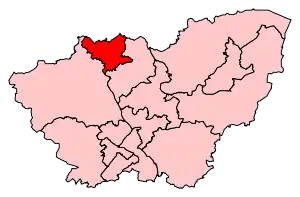 | ||
| Barnsley East | 69,504 | 3,217 | Stephanie Peacock‡ | Jim Ferguson# | Barnsley Metropolitan Borough Council: Cudworth, Darfield, Hoyland Milton, North East, Rockingham, Stairfoot, Wombwell, Worsbrough. |  | ||
| Don Valley | 75,356 | 3,630 | Nick Fletcher† | Caroline Flint‡ | Doncaster Metropolitan Borough Council: Conisbrough and Denaby, Edlington and Warmsworth, Finningley, Hatfield, Rossington, Thorne, Torne Valley. |  | ||
| Doncaster Central | 71,389 | 2,278 | Rosie Winterton‡ | Roberto Weeden-Sanz† | Doncaster Metropolitan Borough Council: Armthorpe, Balby, Bessacarr and Cantley, Central, Edenthorpe, Kirk Sandall and Barnby Dun, Town Moor, Wheatley. |  | ||
| Doncaster North | 72,362 | 2,370 | Ed Miliband‡ | Katrina Sale† | Doncaster Metropolitan Borough Council: Adwick, Askern Spa, Bentley, Great North Road, Mexborough, Sprotbrough, Stainforth and Moorends. |  | ||
| Penistone and Stocksbridge | 70,925 | 7,210 | Miriam Cates† | Francyne Johnson‡ | Barnsley Metropolitan Borough Council: Dodworth, Penistone East, Penistone West. Sheffield City Council: East Ecclesfield, Stocksbridge and Upper Don, West Ecclesfield. |  | ||
| Rother Valley | 74,804 | 6,318 | Alexander Stafford† | Sophie Wilson‡ | Rotherham Metropolitan Borough Council: Anston and Woodsetts, Dinnington, Hellaby, Holderness, Maltby, Rother Vale, Sitwell, Wales. |  | ||
| Rotherham | 61,688 | 3,121 | Sarah Champion‡ | Gerri Hickton† | Rotherham Metropolitan Borough Council: Boston Castle, Brinsworth and Catcliffe, Keppel, Rotherham East, Rotherham West, Valley, Wingfield. |  | ||
| Sheffield Brightside and Hillsborough | 69,333 | 12,274 | Gill Furniss‡ | Hannah Westropp† | Sheffield City Council: Burngreave, Firth Park, Hillsborough, Shiregreen and Brightside, Southey. |  | ||
| Sheffield Central | 89,949 | 27,273 | Paul Blomfield‡ | Janice Silvester-Hal† | Sheffield City Council: Broomhill, Central, Manor Castle, Nether Edge. Walkley. |  | ||
| Sheffield Hallam | 72,763 | 712 | Olivia Blake‡ | Laura Gordon¤ | Sheffield City Council: Crookes, Dore and Totley, Ecclesall, Fulwood, Stannington. |  | ||
| Sheffield Heeley | 66,940 | 8,480 | Louise Haigh‡ | Gordon Gregory† | Sheffield City Council: Arbourthorne, Beauchief and Greenhill, Gleadless Valley, Graves Park, Richmond. |  | ||
| Sheffield South East | 67,832 | 4,289 | Clive Betts‡ | Marc Bayliss† | Sheffield City Council: Beighton, Birley, Darnall, Mosborough, Woodhouse. |  | ||
| Wentworth and Dearne | 74,536 | 2,165 | John Healey‡ | Emily Barley† | Barnsley Metropolitan Borough Council: Dearne North, Dearne South. Rotherham Metropolitan Borough Council: Hoober, Rawmarsh, Silverwood, Swinton, Wath, Wickersley. |  | ||
Constituencies 1997–2010
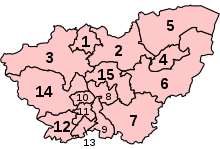
- Barnsley Central BC
- Barnsley East and Mexborough CC
- Barnsley West and Penistone CC
- Doncaster Central BC
- Doncaster North CC
- Don Valley CC
- Rother Valley CC
- Rotherham BC
- Sheffield, Attercliffe BC
- Sheffield, Brightside BC
- Sheffield Central BC
- Sheffield, Hallam CC
- Sheffield, Heeley BC
- Sheffield, Hillsborough CC
- Wentworth CC
Proposed boundary changes
The Boundary Commission for England submitted their final proposals in respect of the Sixth Periodic Review of Westminster Constituencies (the 2018 review) in September 2018. Although the proposals were immediately laid before Parliament they were not brought forward by the Government for approval. Accordingly, they did not come into effect for the 2019 election which took place on 12 December 2019, and which was contested using the constituency boundaries in place since 2010.
Under the terms of the Parliamentary Voting System and Constituencies Act 2011, the Sixth Review was based on reducing the total number of MPs from 650 to 600 and a strict electoral parity requirement that the electorate of all constituencies should be within a range of 5% either side of the electoral quota.
On 24 March 2020, the Minister of State for the Cabinet Office, Chloe Smith, issued a written statement to Parliament setting out the Government's thinking with regard to parliamentary boundaries.[5] Subsequently, the Parliamentary Constituencies Act 2020[6] was passed into law on 14 December 2020. This formally removed the duty to implement the 2018 review and set out the framework for future boundary reviews. The Act provided that the number of constituencies should remain at the current level of 650, rather than being reduced to 600, while retaining the requirement that the electorate should be no more than +/- 5% from the electoral quota.
The Act specified that the next review should be completed no later than 1 July 2023 and the Boundary Commission formally launched the 2023 Review on 5 January 2021.[7] See 2023 Periodic Review of Westminster constituencies for further details.
Results history
Primary data source: House of Commons research briefing - General election results from 1918 to 2019[8]
2019
The number of votes cast for each political party who fielded candidates in constituencies comprising South Yorkshire in the 2019 general election were as follows:
| Party | Votes | % | Change from 2017 | Seats | Change from 2017 |
|---|---|---|---|---|---|
| Labour | 257,978 | 42.3% | 11 | ||
| Conservative | 196,969 | 32.3% | 3 | ||
| Brexit | 82,838 | 13.6% | new | 0 | 0 |
| Liberal Democrats | 47,831 | 7.8% | 0 | 0 | |
| Greens | 14,084 | 2.3% | 0 | 0 | |
| Others | 10,506 | 1.7% | 0 | 0 | |
| Total | 610,206 | 100.0 | 14 |
Percentage votes
| Election year | 1983 | 1987 | 1992 | 1997 | 2001 | 2005 | 2010 | 2015 | 2017 | 2019 |
|---|---|---|---|---|---|---|---|---|---|---|
| Conservative | 28.0 | 24.9 | 27.0 | 16.7 | 18.8 | 18.0 | 20.6 | 17.4 | 29.8 | 32.3 |
| Labour | 48.8 | 56.0 | 57.9 | 62.3 | 59.0 | 52.7 | 42.0 | 49.5 | 56.9 | 42.3 |
| Liberal Democrat1 | 23.0 | 18.9 | 14.5 | 16.6 | 18.0 | 21.4 | 23.7 | 8.2 | 5.9 | 7.8 |
| Green Party | - | * | * | * | * | * | 0.6 | 2.7 | 1.2 | 2.3 |
| UKIP | - | - | - | * | * | * | 4.4 | 20.8 | 4.7 | * |
| Brexit Party | - | - | - | - | - | - | - | - | - | 13.6 |
| Other | 0.2 | 0.2 | 0.6 | 4.4 | 4.1 | 8.0 | 8.7 | 1.6 | 1.5 | 1.7 |
11983 & 1987 - SDP-Liberal Alliance
* Included in Other
Seats
| Election year | 1983 | 1987 | 1992 | 1997 | 2001 | 2005 | 2010 | 2015 | 2017 | 2019 |
|---|---|---|---|---|---|---|---|---|---|---|
| Conservative | 1 | 1 | 1 | 0 | 0 | 0 | 0 | 0 | 0 | 3 |
| Labour | 14 | 14 | 14 | 14 | 14 | 14 | 13 | 13 | 14 | 11 |
| Liberal Democrat1 | 0 | 0 | 0 | 1 | 1 | 1 | 1 | 1 | 0 | 0 |
| Total | 15 | 15 | 15 | 15 | 15 | 15 | 14 | 14 | 14 | 14 |
11983 & 1987 - SDP-Liberal Alliance
Maps
 1983
1983 1987
1987 1992
1992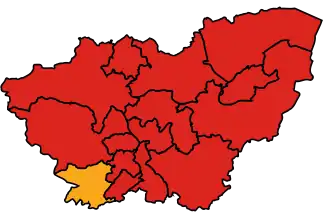 1997
1997 2001
2001 2005
2005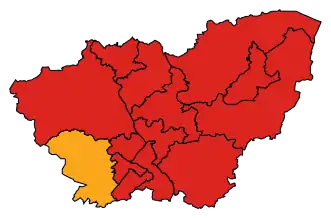 2010
2010 2015
2015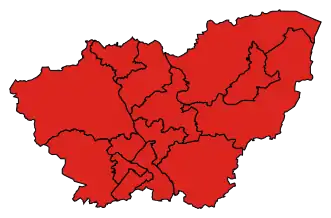 2017
2017 2019
2019
Historical representation by party
A cell marked → (with a different colour background to the preceding cell) indicates that the previous MP continued to sit under a new party name.
Change UK Conservative Independent Labour Liberal Democrats
| Constituency | 1983 | 1987 | 1992 | 94 | 96 | 1997 | 2001 | 2005 | 2010 | 10 | 11 | 12 | 12 | 2015 | 16 | 2017 | 18 | 19 | 19 | 2019 |
|---|---|---|---|---|---|---|---|---|---|---|---|---|---|---|---|---|---|---|---|---|
| Barnsley West and Penistone / P & Stocksbridge (2010) | McKay | Clapham | Smith | → | → | Cates | ||||||||||||||
| Don Valley | Redmond | Flint | Fletcher | |||||||||||||||||
| Rother Valley | Barron | Stafford | ||||||||||||||||||
| Barnsley Central | Mason | Illsley | → | Jarvis | ||||||||||||||||
| Barnsley East (1983–1997, 2010–) / & Mexborough (1997–2010) | Patchett | Ennis | Dugher | Peacock | ||||||||||||||||
| Doncaster Central | Walker | Winterton | ||||||||||||||||||
| Doncaster North | Welsh | Hughes | Miliband | |||||||||||||||||
| Rotherham | Crowther | Boyce | MacShane | → | → | Champion | ||||||||||||||
| Sheffield Attercliffe / Sheffield SE (2010) | Duffy | Betts | ||||||||||||||||||
| Sheffield Brightside / & Hillsborough (2010) | Maynard | Blunkett | Harpham | Furniss | ||||||||||||||||
| Sheffield Central | Caborn | Blomfield | ||||||||||||||||||
| Sheffield Hallam | Osborn | Patnick | Allan | Clegg | O'Mara | → | Blake | |||||||||||||
| Sheffield Heeley | Michie | Munn | Haigh | |||||||||||||||||
| Wentworth / Wentworth and Dearne (2010) | Hardy | Healey | ||||||||||||||||||
| Sheffield Hillsborough | Flannery | Jackson | Smith | |||||||||||||||||
Notes
- BC denotes borough constituency, CC denotes county constituency.
- The majority is the number of votes the winning candidate receives more than their nearest rival.
References
- Baker, Carl; Uberoi, Elise; Cracknell, Richard (28 January 2020). "General Election 2019: full results and analysis". Retrieved 25 April 2020.
- "Constituencies A-Z - Election 2019". BBC News. Retrieved 25 April 2020.
- "The Parliamentary Constituencies (England) Order 2007, page 4". Office of Public Sector Information. Crown copyright. 13 June 2007. Retrieved 7 November 2009.
- Boundary Commission for England pp. 1004–1007
- "Update: Strengthening Democracy:Written statement - HCWS183". UK Parliament. Retrieved 20 April 2020.
- "Parliamentary Constituencies Act 2020".
- "2023 Review launched | Boundary Commission for England". Retrieved 8 January 2021.
- Watson, Christopher; Uberoi, Elise; Loft, Philip (17 April 2020). "General election results from 1918 to 2019".